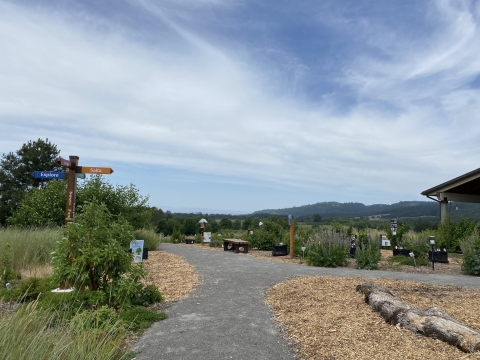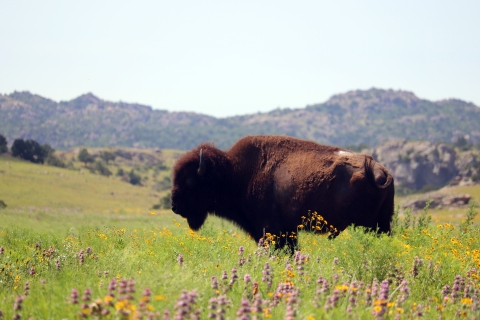National wildlife refuges are not only havens for wildlife, they also serve as critical sanctuaries for pollinators. These incredible insects, mammals, and birds play a vital role in conservation by ensuring the pollination of plants, as well as the production of fruits, nuts, and seeds that support other wildlife. Yet, native pollinators face growing threats from increasing development, disease, and climate change climate change
Climate change includes both global warming driven by human-induced emissions of greenhouse gases and the resulting large-scale shifts in weather patterns. Though there have been previous periods of climatic change, since the mid-20th century humans have had an unprecedented impact on Earth's climate system and caused change on a global scale.
Learn more about climate change . Recognizing their importance, we actively work from coast to coast and border to border, even beyond, to conserve pollinators and their habitats.
Through the National Wildlife Refuge System, one of our land management programs, staff, volunteers, and Friends groups provide a number of opportunities throughout the year to learn about and engage with pollinators and the plant species that support them. National wildlife refuges across the nation organize pollinator events and exhibits. From festivals and guided tours to interactive demonstrations and environmental education programs, wildlife lovers and outdoor enthusiasts of all ages learn about and celebrate the incredible world of pollinators. These opportunities not only educate and entertain the public but also instill a deeper appreciation for, or newfound understanding of, the crucial role pollinators play in nature and in our day-to-day lives. So come join the buzz and celebrate the remarkable pollinators that make our world bloom. Check out the list below for an opportunity near you.
Buzz about the Pollinator Patch at Ankeny Hill Nature Center in Jefferson, Oregon, daily from mid-March to September.
The word garden doesn’t quite define the Pollinator Patch at Ankeny Hill Nature Center. That would be too structured and tended to describe the 4,000-square-foot tapestry of native plants that is meant to help visitors discover the world of native pollinators. Funded by partners and constructed by volunteers, the Pollinator Patch is divided into 10 themed areas. Among them is Bees with Bling, which showcases the 650 native bee species in Oregon, some of which are brightly colored and even shimmering. Here, you can peer into a mason bee house and learn about the life cycle of a mason bee or investigate the demonstration area to learn how to create a similar space in your yard. Explore the dual language English and Spanish interpretive panels that explain the pollination process, reveal how native plants sustain native pollinators, and teach about threats to pollinators.
Roam like a herd of bison at Wichita Mountains Wildlife Refuge near Lawton, Oklahoma, daily from May to August.
There is nothing more iconic than an American bison grazing on the open prairie. While bison aren’t technically pollinators, they do such great work supporting pollinator habitat, I just had to include them here. America’s grasslands provide vital habitat for native pollinators, and bison’s selective grazing on those grasslands increases native flowering plants and pollinators. Recent studies show that bison seem to prefer wind-pollinated grasses that allow insect-pollinated flowering species to flourish. There’s no better place to see this dynamic relationship on display than Wichita Mountains National Wildlife Refuge, where bison and a bit of rain can cause a riot of wildflowers.
Flutter by the Butterfly Festival in October at St. Marks National Wildlife Refuge, St. Marks, Florida.
October brings cooler weather and transport winds for migrating birds and butterflies. Join refuge staff and Friends at the historic St. Mark’s Lighthouse for the annual Monarch Butterfly Festival to learn about Monarch butterfly migration. Monarch butterflies are the most advanced among all known butterfly species, travel up to 2,500 miles from their breeding grounds in Canada and the United States to reach forests in central Mexico. Festival-goers are typically able to witness the tagging and release of these large, brilliant orange, white, and black marathon migrators alongside exhibits and demonstrations, family-friendly crafts, music, food, and more.
Don’t see a nearby refuge here? There is at least one national wildlife refuge national wildlife refuge
A national wildlife refuge is typically a contiguous area of land and water managed by the U.S. Fish and Wildlife Service for the conservation and, where appropriate, restoration of fish, wildlife and plant resources and their habitats for the benefit of present and future generations of Americans.
Learn more about national wildlife refuge in each state, and many have an interest in pollinators. National fish hatcheries also provide space for pollinators. Find a refuge or hatchery near you.
Dr. Lynn Cartmell, Chief of Visitor Services, National Wildlife Refuge System, Midwest Region






